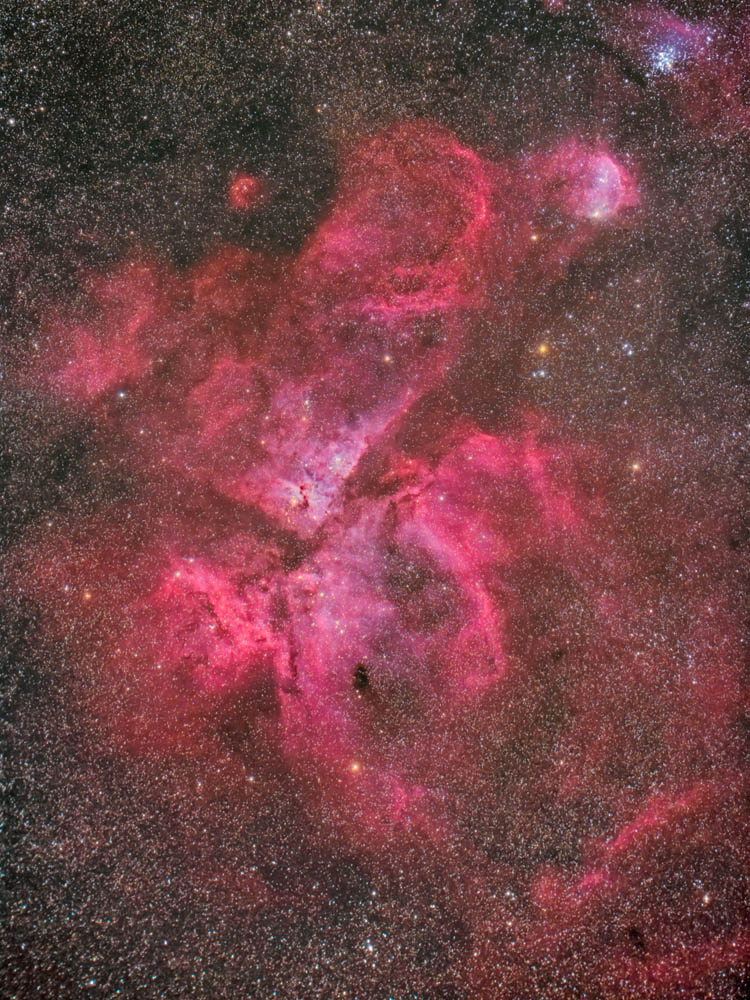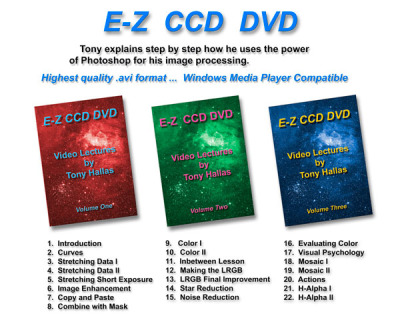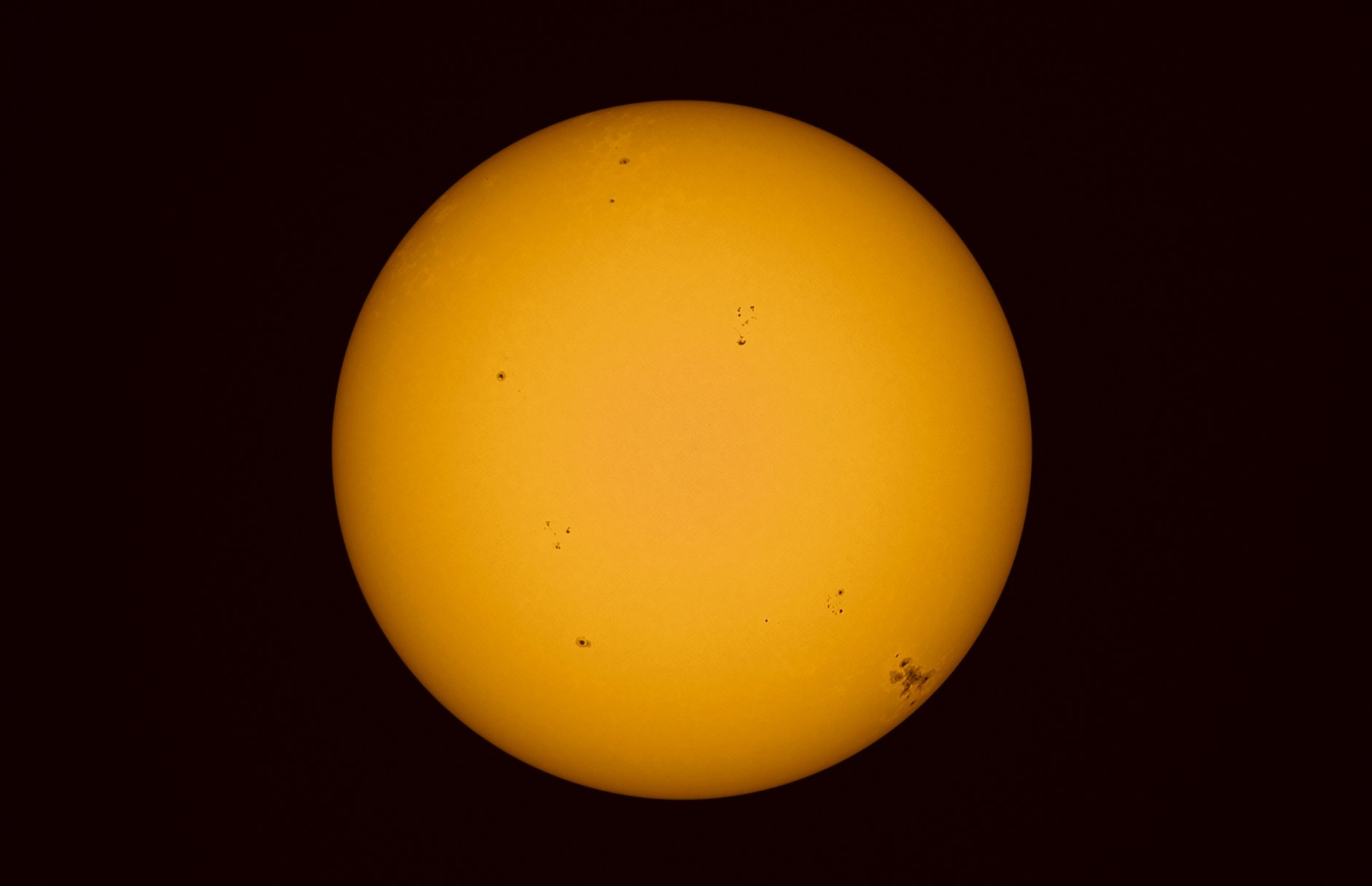Eta Carina from Winter Star Party
 The Eta Carinae NebulaA rare opportunity...to image Eta Carina from the northern hemisphere. I have been to WSP on three occasions and finally had a night for the ages. The transparency on the night of February 11 was incredible. I typically don't hold out much hope for transparent skies down to the horizon where most of the time ocean haze and persistent low clouds tend to hang out. On this night after gathering some very good data on the Witch Head Nebula, we started to get excited about the possibilities of imaging Eta. Our group of imagers began monitoring the sky quality on the ocean horizon early in the evening and we were seeing stars lower and lower as time passed.
The Eta Carinae NebulaA rare opportunity...to image Eta Carina from the northern hemisphere. I have been to WSP on three occasions and finally had a night for the ages. The transparency on the night of February 11 was incredible. I typically don't hold out much hope for transparent skies down to the horizon where most of the time ocean haze and persistent low clouds tend to hang out. On this night after gathering some very good data on the Witch Head Nebula, we started to get excited about the possibilities of imaging Eta. Our group of imagers began monitoring the sky quality on the ocean horizon early in the evening and we were seeing stars lower and lower as time passed.
Eta climbs only a meager 8 degrees or so above the ocean from 24 degrees north latitude on Big Pine Key. We were easily seeing stars at this elevation and even lower, nearly all the way to the ocean horizon. After completing the data acquisition on the Witch Head nebula, I began to prep for imaging Eta.
Just to give you and idea about how low this object is, most of the time our telescopes are pointing nearly straight up into the darkness, but on this night they were pointed nearly horizontal toward one of the largest nebula in the Milky Way Galaxy.
My first glimpse of the camera LCD screen showed the incredible nebulosity complex and I began to get very excited about the opportunity this night was giving to us. A total of 100 minutes of usable data was acquired and here is the final presentation. I will have a future blog on the details around the acquisition of the image. I hope you enjoy the image and that you get a chance to take in the Eta Carinae nebula for yourself through a large telescope at some point in your life.
Please visit the Color Astronomical Gallery and click on the image for a larger presentation. You may also purchase a fine art print of Eta Carinae by either emailing me, phoning, or simply using the online purchase option.
A new tool for astrophotography enhancement
 EZ CCD DVD by Tony Hallas is a new tool for the astrophotographer to improve their image enhancement skills. I just completed viewing the 3 DVD set and here are the answers to your questions:
EZ CCD DVD by Tony Hallas is a new tool for the astrophotographer to improve their image enhancement skills. I just completed viewing the 3 DVD set and here are the answers to your questions:
- Is it worth the $68? Yes. You have to remember, as much as I have studied Photoshop and processing, I still approach the subject as "unknowable." I always learn something from every course I digest. What I particularly like about this DVD series is that you are basically sitting at Tony's side as he works through M81 processing from post-reduction to final print. You work through stretching of luminance and application of RGB with the utmost attention to detail. This is the definition of Fine Art Photography.
- Will it make my images better? Yes. There were moments when I had the DVD running on my laptop with my M31 open in Photoshop and applied the current lesson to the image. The image was improved by at least 20% through these new approaches. In particular, application of the spunge and high pass filters were most useful for this image.
- Will I learn something? Yes. I have studied with many of the country's top landscape photographers and image enhancement and compositional consideration were a part of those instructions. I still learned many new techniques and more importantly how to apply them at my artistic taste.
- Who is this for? Are your frustrated with your image processing? Do you not know how to effectively use masks and filters to enhance selected parts of your image? Do you have a pretty good understanding of Photoshop, but want to go a bit deeper into the water? Then this DVD set is for you.
The DVDs contain video files of Tony lecturing during his workflow in addition to some lectures on color, visual psychology, mosaic construction, and hydrogen alpha enhancement. The DVDs are focused on enhancing 16 bit fit files converted to TIFF, which is a bit different from my current workflow with RAW converted DSLR images. So my stretching of TIFF data is a bit different than what Tony presents, but after the lecture on stretching, all other techniques are certainly viable for any astrophotographer regardless of how the data was captured.
I had to chuckle on his "green gun" technique as I recall when he introduced that to the old film astrophoto list many years ago. It is still a very viable technique and one that every astrophotographer should be aware of.
What I like most about Tony's presentation is that he is first and foremost an artist with a vision. You may or may not find his final art product to your liking, that is the nature of the beast, but what he does do is share with you what is possible and encourages you to explore those possibilities that match your own artistic voice. That is what is really important, developing your own artistic eye. While it is important to be keenly aware of the enhancement tools at your discretion, ultimately it is your ability as an artist to visually interpret the data and present it in a way that meets your artistic vision and pleases your intended audience.
That is exactly what I like to focus on when working with imagers, finding their own artistic vision and reconciling their work to meet that vision. If you find yourself not satisfied with your work, you know that something is just not right, give me a call and we can discuss some of the ways to find meet your vision through your image optimization approach.
You can purchase the DVD set directly from Tony here or from Astro-Physics here.
Less is more...
In digital astrophotography, the key is to capture more signal to overcome the noise. You know noise when you see it and I am not going into a deep technical explanation of how it originates and what it is, but I know it when I see it.
I started astrophotography with the 350D and saw noise, especially color noise, that I knew had to be dealt with by traditional noise reduction methods. Those methods involve subtracting dark frames from the light frames.
Later I began using the Canon 450D and noticed a huge difference in noise. There was hardly any to speak of, even after moderate stretching of the data. This led me to experiment with a new way of optimizing the data without utilizing dark frame subtraction. That new technique is detailed in the archived webinar under the "digital photography education" tab.
Now comes the 500D and thankfully dedicated astronomers like Gary Honis put together bench testing of cameras so we know how they will perform. The 500D has even lower noise than the 450D and offers those ultra-high levels of ISO up to 6400. Now this will be exciting and is why I am ordering one soon.
Here is a link to Gary's test. This is a new day in DSLR photography, one that I hope will see the end to autoguiding as well as dark frame subtraction. Enjoy the new day!
On-Line Education Webinar is now posted...
Recently, two fellow astro-imagers joined me for a webinar where we discussed utilizing Adobe Light Room for processing RGB astronomical images. What a wonderful way to share information and provide education in today's world. This archived webinar serves as an example of the new on-line educational services I am providing. You can now access this highly customized one-on-one training from the comfort of your digital darkroom. You and I will share applications and discuss ways to optimize your landscape or astronomical images in real-time. It is a wonderful way to achieve your vision of the final image you captured in the field or under the stars.
For more information on the services and to see the webinar, please go to Purchase, Digital Photography Education from the main menu.
I hope you enjoy the presentation and simply email me if you would like to schedule a one-hour on-line session today.
Photographic education
Photographic education never ends. The sources I utilize for continuing education are listed in the links section to the right. Most recently, Charles Cramer provided an update to his Photoshop handbook to his email subscribers for free! Charles is one of, if not the best, photographic instructors in the word today. I owe a great deal of my improvement to his instruction and photographic examples. The update covers a lot of the changes with PS CS4 and there were a lot of changes. I encourage you to visit his website and sign up for his newsletter and to certainly look into taking one of his workshops. I hope to attend one of his Yosemite workshops in the next couple of years myself. One additional note is that I have been working very diligently on the Smoky Mountain portfolio or "folio." This will be an entirely new presentation and one that I really find conducive to my artist vision. I will keep you updated as the folio nears completion. I am expecting the folio to be completed in the next couple of months. Take care and have a great Thanksgiving.
Jeff's Blog
Join me on photography journeys from desert landscapes to deep sky wonders.





















